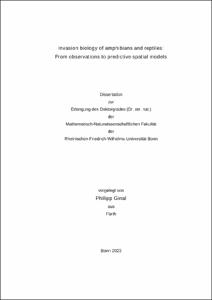Invasion biology of amphibians and reptiles: From observations to predictive spatial models

Invasion biology of amphibians and reptiles: From observations to predictive spatial models

| dc.contributor.advisor | Rödder, Dennis | |
| dc.contributor.author | Ginal, Philipp | |
| dc.date.accessioned | 2024-04-04T11:02:42Z | |
| dc.date.available | 2025-04-15T22:00:27Z | |
| dc.date.issued | 04.04.2024 | |
| dc.identifier.uri | https://hdl.handle.net/20.500.11811/11473 | |
| dc.description.abstract | My thesis entitled “Invasion biology of amphibians and reptiles: From observations to predictive spatial models” comprises of six publications (see bibliographic information below for details). Overall, my thesis is broadly-folded, comprises several target species across different taxonomic groups (i.e., anurans, urodeles, squamates), scales (i.e., local, regional, macro-ecological landscapes) and methodological approaches (i.e., population size estimation, connectivity modelling, correlative and mechanistic species distribution modelling, mechanistic quantification of activity time budgets). The focus of my thesis relies on the methodological approaches and therefore, the red line in here starts with relatively simple models and ends with a novel, complex mechanistic approach. Furthermore, three publications consider the African Clawed Frog, Xenopus laevis (Daudin, 1802), which is among the most invasive amphibian species of the world. Two further publications focus on the Oriental Garden Lizard, Calotes versicolor (Daudin, 1802) complex, a wide-spread but neglected invader with potential negative impacts, and the Italian Cave Salamander, Speleomantes italicus (Dunn, 1923), which is non-native but locally very restricted with no known negative impacts yet. Another publication considers the invasive fungal disease Batrachochytrium salamandrivorans Martel et al. 2013 (Bsal), which has substantial negative impacts on macro-ecological scales, and one of its host species, the European Fire Salamander, Salamandra salamandra (Linnaeus, 1758). | en |
| dc.language.iso | eng | |
| dc.rights | In Copyright | |
| dc.rights.uri | http://rightsstatements.org/vocab/InC/1.0/ | |
| dc.subject | Invasionsbiologie | |
| dc.subject | Herpetologie | |
| dc.subject | Amphibien | |
| dc.subject | Reptilien | |
| dc.subject | SDM | |
| dc.subject.ddc | 570 Biowissenschaften, Biologie | |
| dc.title | Invasion biology of amphibians and reptiles: From observations to predictive spatial models | |
| dc.type | Dissertation oder Habilitation | |
| dc.publisher.name | Universitäts- und Landesbibliothek Bonn | |
| dc.publisher.location | Bonn | |
| dc.rights.accessRights | openAccess | |
| dc.identifier.urn | https://nbn-resolving.org/urn:nbn:de:hbz:5-75555 | |
| dc.relation.doi | https://doi.org/10.1007/s10530-022-02903-6 | |
| dc.relation.doi | https://doi.org/10.21425/F5FBG54299 | |
| dc.relation.doi | https://doi.org/10.1002/jez.2432 | |
| dc.relation.doi | https://doi.org/10.3897/neobiota.64.60004 | |
| ulbbn.pubtype | Erstveröffentlichung | |
| ulbbnediss.affiliation.name | Rheinische Friedrich-Wilhelms-Universität Bonn | |
| ulbbnediss.affiliation.location | Bonn | |
| ulbbnediss.thesis.level | Dissertation | |
| ulbbnediss.dissID | 7555 | |
| ulbbnediss.date.accepted | 02.02.2024 | |
| ulbbnediss.institute | Angegliederte Institute, verbundene wissenschaftliche Einrichtungen : Zoologisches Forschungsmuseum Alexander Koenig (ZFMK) | |
| ulbbnediss.fakultaet | Mathematisch-Naturwissenschaftliche Fakultät | |
| dc.contributor.coReferee | Wägele, Wolfgang | |
| ulbbnediss.contributor.orcid | https://orcid.org/0000-0001-6491-554X | |
| ulbbnediss.date.embargoEndDate | 15.04.2025 |
Dateien zu dieser Ressource
Das Dokument erscheint in:
-
E-Dissertationen (4337)




